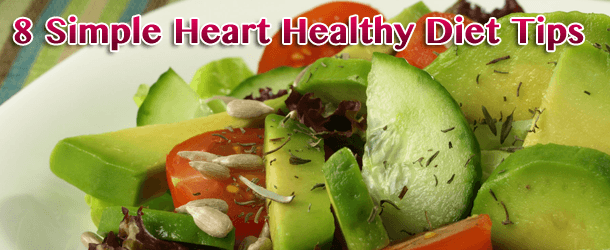
While some heart disease risk factors, such as family history, are out of your control, a healthy diet and lifestyle are your best weapons. Start improving your diet today with these 8 simple heart healthy diet tips:

1. Go bananas. One banana has 422 mg–about 12 percent of your recommended daily dose–of potassium. Research suggests that diets rich in potassium can help lower blood pressure. Other good sources include sweet potatoes (694 mg for one medium), nonfat yogurt (579 mg for 1 cup) and spinach (419 mg for cup, cooked).
2. Eat the right fats. Studies suggest that replacing saturated fats (e.g., butter) with plant-based sources of polyunsaturated and monounsaturated fats may help lower blood cholesterol. Sources of polyunsaturated fats include corn and soybeans, and many nuts and seeds and their oils. Monounsaturated fat sources include canola, olive and peanut oils, and avocado.
3. Shell out. Nuts and seeds tend to be very high in fat and calories, but generally most of the fat is the heart-healthy polyunsaturated or monounsaturated kind. Some varieties, however, such as macadamia nuts, are also high in saturated fat, so check labels.
4. Scan labels for “sat fat” counts. Use the percent of daily value (DV) information on a product’s Nutrition Facts label to help you decide if the food is a smart choice from a saturated-fat perspective. Five percent or less of the DV is low–and a good choice. Twenty percent DV or more is high–and “red flags” the food as one to limit. Low-fat Cheddar, which contains 1.2 grams of saturated fat (6 percent DV) per ounce, is significantly lower in saturated fat than its full-fat counterpart (which weighs in at 6 grams of saturated fat, or 30 percent DV, per ounce).
5, Shop around for low sodium. Compare sodium content for similar foods and you can save hundreds of milligrams of sodium. For example, the sodium content for frozen pizzas ranges from 450 mg to more than 1,200 mg. The range among salad dressings is 110 to 505. Salsas: 120 to 240.
6. Be a sodium sleuth. When dining out, watch out for high-sodium foods. Sneaky sodium sources include anything that’s pickled, smoked or served in a broth or “au jus.” Cocktail, soy and teriyaki sauces also are packed with sodium.
7. Give new grains a try. Make buckwheat pancakes. Serve stir-fry over bulgur. Substitute millet for rice in curry dishes. Whole grains have more fiber and nutrients than refined carbohydrates.
8. Choose fruit. A cup of fruit juice offers vitamins, minerals and other phytochemicals, but if you’re watching your weight, whole fruits are smarter choices. They contain more fiber, which helps you feel full, and fewer calories. For example, one medium orange has 62 calories and 3 grams of fiber, whereas an eight-ounce glass of OJ has about 120 calories and no fiber.
– Nicci Micco, M.S.
EatingWell is a magazine and website devoted to healthy eating as a way of life. Online at www.eatingwell.com.
(c) 2012 Eating Well, Inc. DISTRIBUTED BY TRIBUNE MEDIA SERVICES, INC.

